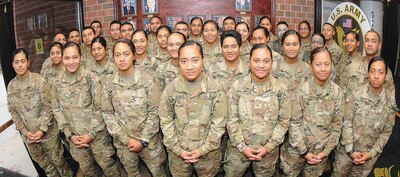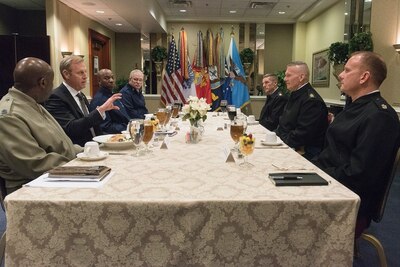By Terrance Bell U.S. Army Garrison Fort Lee
FORT LEE, Va., Nov. 28, 2017 — Enlisting in the Army with a
childhood friend or relative is a generations-old practice meant to bring
familiarity and comfort to an experience fraught with stress and uncertainty.
So, does signing up with more than one recruit further ease
the difficulties associated with initial military training?
The answer is an emphatic "yes" as it relates to
members of a Samoan family with a decidedly large footprint here. There are 41
of them enrolled in various Sustainment Center of Excellence courses here,
twisting the old adage "strength in numbers."
"This is good for us," said 30-year-old Army Spc.
Joseph Tauiliili, assigned to Papa Company, 244th Quartermaster Battalion, and
the oldest among relatives in various stages of advanced individual training.
"We come from American Samoa, and we're basically thousands of miles away
from home. Seeing them by my side keeps me motivated every day."
American Samoa is a U.S. territory and part of the Samoan
Islands, an archipelago that also includes the independent nation of Samoa. It
is located in the Pacific Ocean roughly 2,500 miles southwest of Hawaii and a
little over 2,000 miles northeast of New Zealand.
The Samoans in training here -- first, second, third and
fourth cousins -- hail from Poloa, an area near the capital city of Pago Pago.
All are related to the same malietoa, or chieftain. Their decision to join in
close proximity was partly based on strong familial and cultural ties, said
Army Pvt. Siiva Tuiolemotu, assigned to Whiskey Company, 244th Quartermaster
Battalion.
"We wanted to stick together in training," the
20-year-old said, noting her country's communal culture.
Various Courses
Most of the Samoans are training in the Unit Supply
Specialist Course taught at the Quartermaster School. A few are enrolled in
courses for other quartermaster military occupational specialties, and at least
one attends the Ordnance School.
American Samoa, which has struggled economically, boasts
strong traditions of military service, Tuiolemotu said. In 2014, a local Army
recruiting station was the most productive in the world, according to the Samoa
News website. Still, kinship is what drives most to take the oath of service.
"The thing we care about is supporting our
families," she said. "If that means [sacrificing] our lives, yes, we
have to fight for them."
It also is legacy. Many of the soldiers are the latest to
uphold family traditions.
"Most of my siblings are in the military, and I'm the
youngest, so I wanted to follow in their footsteps," said 25-year-old Army
Pfc. Vasait Saua, Whiskey Company, 244th Quartermaster Battalion.
Army Pvt. Talalelei Ames said his parents also spent time in
uniform and that his father is a retiree. Enduring long periods of separation
while they served, he said, his military ties were not strong, but that has
changed since he took the oath.
"Wearing the uniform makes me feel I am more connected
to them," the 19-year-old soldier said. "I think it's pretty awesome.
I never had this much fun in my life and never had this much responsibility.
Now, I know what my parents went through to protect the country."
Close-Knit Family
The question of whether the Samoans are a close-knit clan or
a loose group of relatives was answered during a recent photo session. Army
Sgt. Maj. Micheal Lambert, sergeant major for the Quartermaster School's
logistics training department, organized the gathering. He said there were
smiles, hugs and kisses reminiscent of a family reunion. To top it all off, he
added, they postured as if performing a traditional dance complete with
contorted facial expressions.
"They are definitely a family," he said.
At some point during their training, the Samoans must face
an inherent component of Army life: family separation. The sheer number of
Samoans wearing uniforms, however, along with the richness of Samoan culture,
is comforting in light of the prospect, Tuiolemotu said.
"I'm the first one who will leave the group," she
said, noting a pending assignment to Fort Riley, Kansas. "I'm not worried,
because there are a lot of us out there. I'm bound to meet another relative
somewhere. That's for sure."









